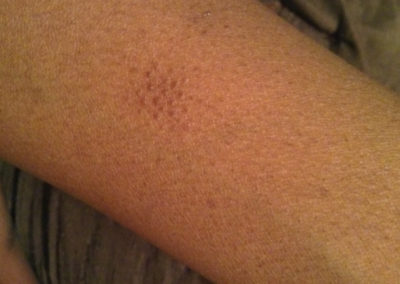Lichen Spinulosus
Medically reviewed by The Dermatologists and written by Dr. Alexander Börve
Common
- Requires medical diagnosis
- Symptoms: Sudden onset of rough bumps
- Color: Typically flesh-colored
- Location: On the neck, thighs, knees or arms
- Treatment: No known cure; no treatment necessary; topical creams, pumice stones or laser hair removal
ICD-10: L43.9
ICD-9:697.0
Lichen spinulosus is a benign skin condition that is marked by patches of small rough bumps. The cause is unknown, but it may be triggered by infection, genetics, or allergies.
It is not dangerous and is not associated with any abnormalities of other organ systems. It is generally only a cosmetic concern. Although rare, it seems to affect children, adolescents, and young adults most frequently. It affects males and females roughly equally and displays no racial predilection.
Try our FREE dermatology search engine and get peace of mind within a second
Symptoms
The disease tends to have a sudden onset of rough bumps. Individual bumps are flat or slightly dome-shaped. They are usually flesh-colored, small (1-3mm in diameter) and have a pointed edge around the tip of the follicle.
These lesions usually appear on the neck, thighs, knees and arms. They can group into large plaques that can spread rapidly to affect large areas of the skin, including buttocks and the abdomen. The patches usually have a diameter of 2-5 cm and occur symmetrically on the body. When a patch is rubbed gently with the fingers, it feels similar to a nutmeg grater.
The disease is usually asymptomatic other than the rash, but some individuals have reported itching associated with the rashes.
Try our FREE dermatology search engine and get peace of mind within a second
What can I do?
You can use emollient keratolytics to improve the condition. Topical lactic acid, salicylic acid, and urea gels or ointments are also useful. Treating underlying conditions and correcting vitamin deficiencies may offer some improvement as well.
Should I seek medical care?
Without treatment, most cases of LS resolve within 1-2 years, although resistant cases can last for decades. If the appearance of lichen spinulosus bothers you or if over-the-counter creams do not improve your situation, you should seek help from a healthcare professional.
In addition, you should seek medical care immediately if you have the following diseases, because a more severe variant may occur in association:
- Nodulocystic acne
- Type VI (HIV-associated) pityriasis rubra pilaris
- Crohn’s disease
- Hodgkin’s disease
- Seborrheic dermatitis
- Syphilis
- Id reactions to fungal infections
- Heavy metal ingestions
Try our FREE dermatology search engine and get peace of mind within a second
Treatment
Most cases tend to resolve spontaneously at puberty, without treatment.
Although incurable, the bumps can be alleviated by topical creams, pumice stones or laser hair removal. Creams with salicylic acid, lactic acid and/or urea are often used as treatment, while tretinoin gel at bedtime with hydroactive adhesives applied the following morning has also been reported to be effective.
Try our FREE dermatology search engine and get peace of mind within a second
Source:
American Osteopathic College of Dermatology. Lichen Spinulosus. Available at: https://www.aocd.org/?page=LichenSpinulosus
Ask a Dermatologist
Anonymous, fast and secure!

The Specialist doctor from the University Hospital in Gothenburg, alumnus UC Berkeley. My doctoral dissertation is about Digital Health and I have published 5 scientific articles in teledermatology and artificial intelligence and others.


